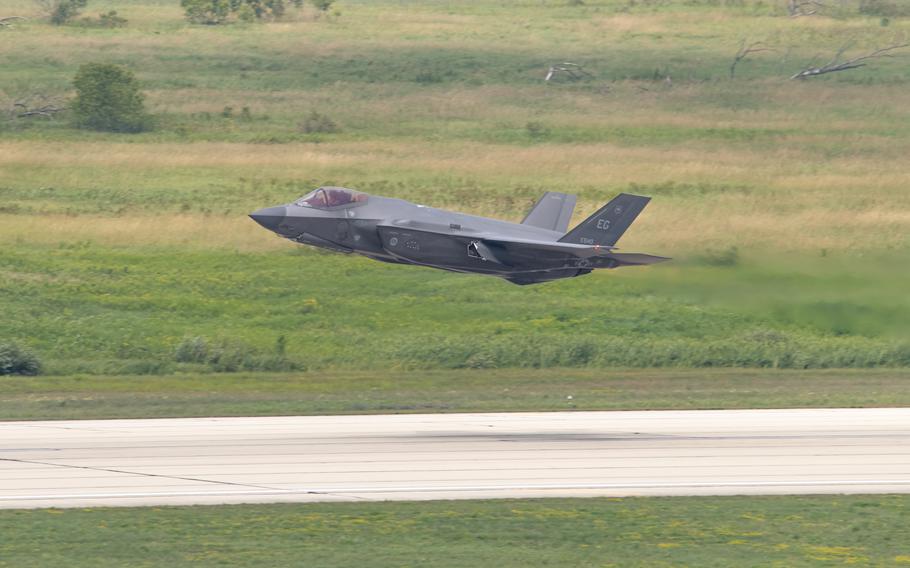
A U.S. Air Force F-35 Lightning II, assigned to the 33rd Fighter Wing, Eglin Air Force Base, Fla., takes off during a training flight as part of exercise Northern Lightning at Camp Douglas, Wis., Aug. 9, 2023. (Kregg York/U.S. Air National Guard)
The U.S. military is the strongest in the world, but the physical size of our military is not what has positioned us as the most powerful in the world. The generational strength of the U.S. military is due to our brave men and women, superior technology, and continuous innovation. The U.S. armed forces showcase the technological prowess our nation has to offer, and, among our service branches, our military develops and utilizes some of the most advanced technology in the world.
Among our most advanced military technologies is the F-35 fighter jet. Overseen by the Pentagon’s F-35 Joint Program Office, the F-35 program is one of the most renowned initiatives deployed by the military. As an asset to the U.S. Air Force, the U.S. Marine Corps, and the U.S. Navy, F-35s are being procured and utilized throughout the armed forces.
Despite the high demand of the F-35, the more recent focus on the program is the F135 engine. Originally produced in 2009, the F135 engine has exceeded nearly all engineering expectations. With increased thrust and thermal management capacity, adaptive controls, advanced materials, and design-for-sustainment modular architecture, the F135 engine is a testament to the military’s advanced technological innovation.
Having been upgraded over the years, the F135 continues to perform well. But by the end of the decade, it has been predicted that the F135 engines we use today will not have the capacity to power future air vehicles. Taking these constraints into consideration, a propulsion upgrade is urgently needed if we are going to continue to produce F-35s at the rate they are being requested by our military and our allies. Although the F135 engine has proven to be a pillar of the F-35 fighter jet, some members of the U.S. House of Representatives have contested the upgrade, pushing for the implementation of an entirely new propulsion system.
In early June, the House passed the fiscal year 2024 National Defense Authorization Act, allocating more than $588 million in funds toward the implementation of a new propulsion system for F-35 fighter jets through the Adaptive Engine Transition Program. Although the Pentagon explicitly decided to not request funding for the AETP engine and instead move forward with the Engine Core Upgrade plan, looking to fully upgrade the current F135 engines, some members of the House are pushing for a program that will waste millions of taxpayer dollars.
Multiple branches of the military have made clear their concerns with the funding of the AETP engine. The new propulsion system, under this program, is unusable for the Marine Corps variant of the F-35 and may also not work on the F-35 Navy variant. Being the only branch to benefit from this program, the Air Force would be the sole proprietor of this new technology. F-35 Program Executive Officer Lt. Gen. Eric T. Fick told reporters that the Air Force would have to bear the cost of development all on its own, considering it would be unfair for the Navy, Marine Corps, and partners of the F-35 program to foot the bill for a technology they can’t even use.
Fortunately, the Senate has listened to the Defense Department’s apprehension, as the Senate version of the NDAA opted to fund the engine upgrade of the F135 engine. The current NDAA not only provides the proper funding for the F135 modernization efforts, but also prohibits the integration of alternative engines into any of the F-35 variants. Now, the F135 engine will receive the undivided attention it requires, and all branches of our military will be able to procure and utilize F-35 fighter jets for decades to come.
While our national defense relies on developing new technologies, it is just as crucial to improve preexisting equipment when needed. Implementing a new propulsion system for the F-35 fighter jets will only waste millions in taxpayer dollars that could otherwise be spent on other needed programs. During these current times of geopolitical uncertainty, every dollar counts, and we must properly allocate our resources to best prepare for the future.
Terron Sims II, a West Point graduate and U.S. Army combat veteran, is a former deputy chief of training for the Joint Readiness Training Center and Fort Johnson (formerly Fort Polk), La.